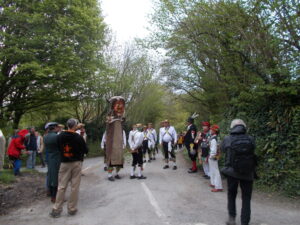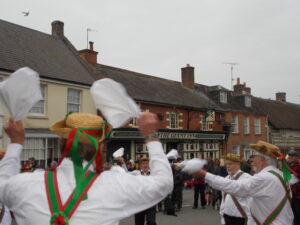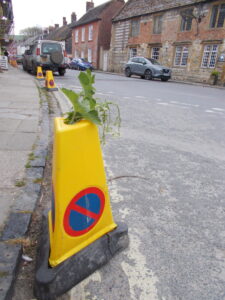In a year filled with chalk giants on hillsides, Jon Woolcott found himself caught between ancient and modern; sacred and profane.

This year my dreams have been etched with figures: giants and crosses, horses, a kiwi, a lost panda and a found stag. These hauntings dance on hilltops, shiver in the cold, are bright in the winter sun, and fade exhausted into summer’s long grass. They have suggested themselves to me on distant hillsides, sometimes when they’re not present, maybe where they once were. They are real and mysterious, created, scoured and sometimes lost. They’re not stable, they shift, they are ancient, they are modern.
Chalk figures are landscape art. They’re a feature of southern English downland – you need height for perspective, and chalk for whiteness, and both are provided abundantly in these landscapes. A few are outliers, far from the chalk. A stag made from quartz boulders has recently been rediscovered on Scotland’s east coast, and in Warwickshire, on clay, there was once a figure, preserved now only in the name of the area: Vale of the Red Horse. But Wiltshire is the county of the chalk horse, and most are relatively recent – eighteenth or nineteenth century, except for the genuinely ancient Uffington horse (or possibly dragon), over the border in Oxfordshire. As a child growing up in southern Wiltshire, hill figures were fascinating and common, but as an adult it was one of the best-known which drew me again and unlocked something lurking in my imagination.
At first light on May Day I drove to Cerne Abbas, in Dorset. It was cold, the sky was a pale and unyielding grey. In the village pagans and gentle hippies abounded, hundreds of people, remarkably fresh-faced, some with hair garlands or carrying sprigs of oak. One couple wore fake pigtails and horned plastic helmets. There were almost as many dogs as people. A Land Rover disgorged a Morris troupe, entirely of men, bearded and mostly in later middle age, although one younger man looked as if he might be the sole hope of keeping the tradition alive. They were accompanied by the Dorset Ooser, eight feet tall, a wooden face and horns, the Morris’ spirit and ungainly sprite. They had been dancing since dawn on the Trendle, the square-shaped earthwork above the famously priapic Giant’s head, but they showed no sign of slacking. The crowd followed the Morris dancers down the lane, and I followed the crowd. One dancer knocked loudly on a front door, telling everyone that this was the home of a television journalist, famous for her reports from war zones. She will have been woken by a lot worse. Outside a pub, open very early for the revellers, I found my friend Martin who was, in his words, ‘three pints in.’ He was sporting a small sprig of cow-parsley behind his right ear, under his cap. It was just after seven o’clock. The Morris troupe assembled, danced and beat sticks, and dropped them only once, shavings sparking harmlessly. The accordion player, bearded, colourfully dressed and solemn-faced, calling to mind something of Thomas Hardy in his last years, wheezed out their songs. One of the players, Martin told me, was called Alan Twelve Trees. They played Beethoven’s ‘Ode to Joy’, the European anthem, and everyone applauded politely. The music was interrupted only by the car alarm from their Land Rover, parked outside the church, where the vicar sat on a low wall, texting.

There’s only so much Morris you can take, and the Morris knew this too, packing up, sending round a plastic tray for coins and notes. At Saint Augustine’s Well, a spring next to the churchyard, people were gathering under the trees. This is a spot where little handwritten notes are left for the departed, tied to the branches of the sheltering canopy, but the votive offerings were stripped back that morning, a chalkboard asked that we respect this sacred well by leaving only ‘fully biodegradable’ mementoes and tributes. I took a service sheet from a woman who was worried she wouldn’t have enough to go round. The vicar, dressed in civilian clothes, asked if we could begin in silence, by listening to the birdsong and the babble of the spring. He crouched, ran his hand through the water, and invoked the spirit of the place. The short service was Christian and Pagan, a tacit and gentle acknowledgement of the melding of traditions. It’s inevitable in Cerne Abbas – The Giant sits on the hill immediately above the site of a huge Benedictine Abbey, of which only the gatehouse remains, on private land but accessible.
The Giant’s age is contested. Originally he was thought to be old, not as old as Uffington, but Romano-British, a figure of Hercules. The more Pagan you are, the more likely you are to believe this theory. But The Giant doesn’t appear in the written record before the late seventeenth century, so some think he dates from the period around the Civil War, a lampoon of Oliver Cromwell, charging across the land, destroying everything in his wake. The Giant is a hard figure to pin down, made worse by his tendency to sink back into the land – this September I was shocked to see how faded he was, how much in need of scouring, of repair. And sometimes the repair makes him shift, slide or grow. Late nineteenth century scouring mistakenly incorporated his belly button into the tip of his penis, extending it impressively. The two sides of the debate, Roman or early modern, were intractably dug into their positions, but during the Pandemic’s furies chalk sampling was carried out, establishing that neither side were right, that The Giant was Saxon, from around 800 CE. Neither the Herculeans nor the Cromwellians are yet convinced by this new evidence.

The vicar asked members of his informal congregation if anyone wanted to read from the Bible and there was no shortage of volunteers. We bowed our heads and at the service’s conclusion were offered wild garlic pesto on crackers. I fell into conversation with a writer and musician who turned out to be the Dream Pop pioneer Virginia Astley, and we talked about her new projects – west Dorset church porches, Hardy and architecture, resonance and portals.
Here, under the trees, adjoining a churchyard, below a shifting, naked, indeterminably-aged giant and a lost abbey, between the profane and the sacred, the Christian and the Pagan, close to the Morris, midway between the spring equinox and midsummer, the road noise rumbling up in early morning; at that moment I thought I might be at the very centre of the world.
***
Jon Woolcott works for the independent publisher and bookshop, Little Toller Books. His book ‘Real Dorset’ (Seren, £9.99) is out now. He is researching a new book. Follow him on Instagram @dorsetjonw.